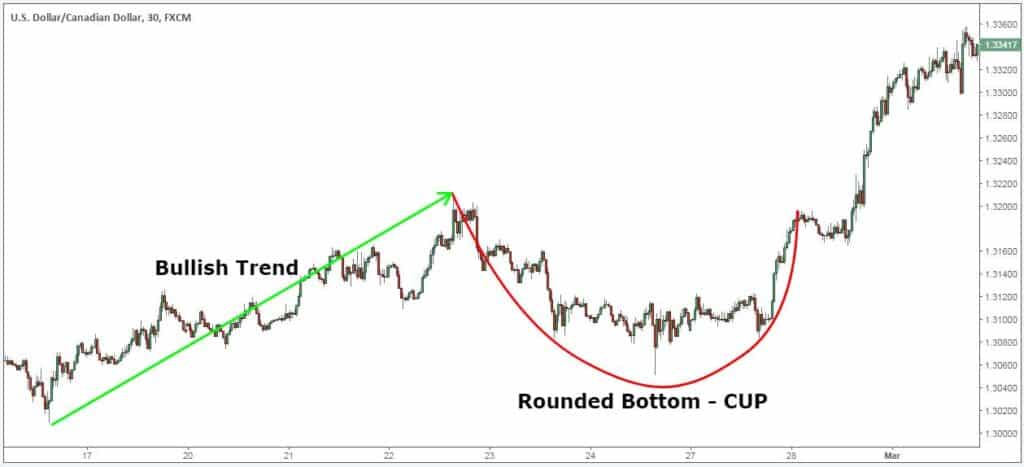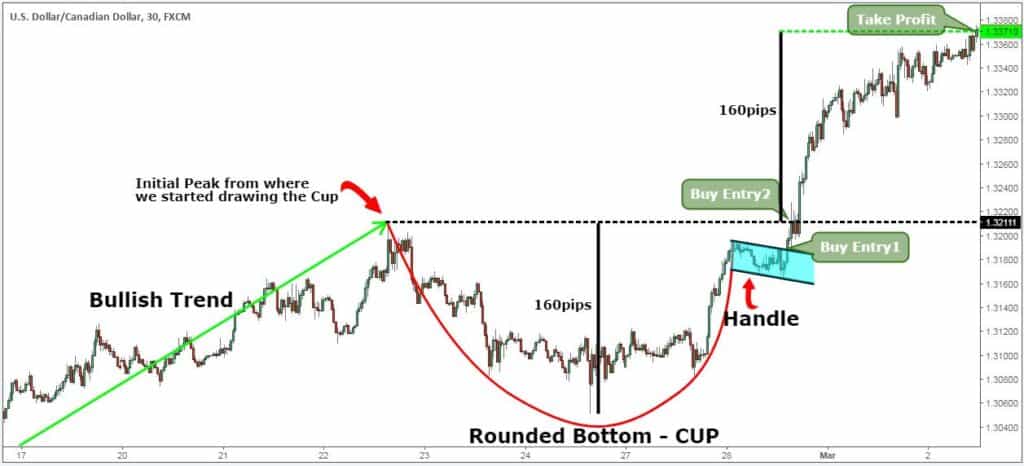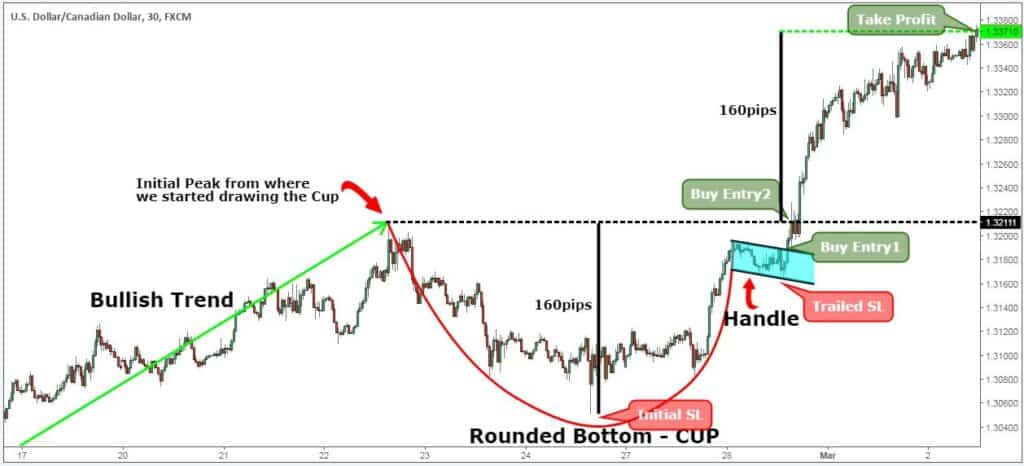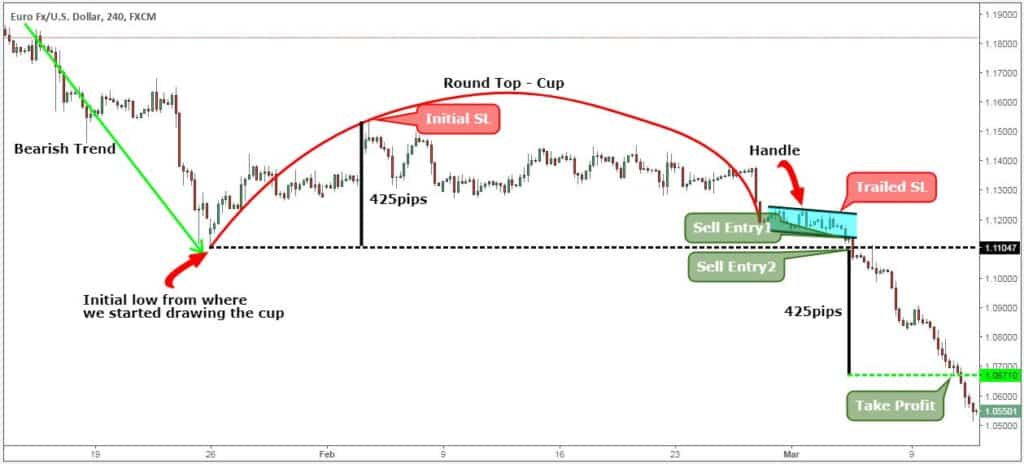Profitable Cup and Handle Pattern Trading Strategy

This article will teach you everything you ever need to know to succeed with the cup and handle pattern. We have many examples, and by the time you finish this article, you will know precisely how to trade the cup and handle pattern.
The profitable Cup and Handle trading strategy might be a humorous name. However, the cup and handle pattern has a long history and was discovered by the famous trader William J. O’Neil. He founded the stock brokerage firm William O’Neil & Co. Inc.

Thanks for visiting Trading Strategy Guides (TSG)!
You have discovered the most extensive library of trading content on the internet. Our aim is to provide the best educational content to traders of all stages.
Learn Our Trading Best Strategy By our Founder Casey Stubbs
In other words, we want to make YOU a consistent and profitable trader.
If you’re a brand new trader, we recommend hopping over to our ultimate beginner’s guide to trading to learn more.
If you want to become a cup-and-handle trader, you can read William O’Neil’s book, “How to Make Money in Stocks.” Or you can simply read the full version of the Cup and Handle trading strategy by reading this article.
Our team at Trading Strategy Guides is working hard to develop the most comprehensive guide on different chart pattern strategies. To understand the psychology of a chart pattern, please start here: Chart Pattern Trading Strategy step-by-step guide.
Table of Contents
Is the Cup and Handle Pattern Trading Strategy Reliable?

As the name suggests, the cup and handle pattern has a similar appearance to a teacup with a handle.
At TSG, we believe the Cup and Handle is one of the most authentic continuation patterns. Unlike the bullish flag pattern, which is a continuation pattern, the cup and handle pattern takes much time to develop. This is why it’s such a reliable pattern.
Now, let’s get a little bit deeper into what this is and how to make money trading with the profitable Cup and Handle trading strategy. Also, feel free to read the simple yet profitable strategy.
What Is a Cup and Handle Pattern?
This particular pattern is a bullish continuation pattern. It typically has a run-up on the left side. You’ll see an uptrend that stops and forms a peak. Then, it’s followed by a retracement back down, creating a cup-like bottom or a rounded bottom.

So, the first cup and handle rule is that you need to have a previous trend. It would be best to have this to have a continuation pattern.
The bottom of the pattern will dip about 15% to 50% from the peak. That is the depth of the cup that you want to look for. If you drop lower than 50% from the peak, then the pattern is invalidated. The handle portion is a retracement downwards from the right side of the cup.
It’s important to remember that the handle section of a cup and handle pattern should resemble a very narrow price range. It can be contained inside two parallel lines or take the shape of a smaller, rounded bottom.
Usually, the handle of a teacup can take many shapes. This can be the same when reading the price action for the cup and handle formation.
We can sum up the cup and handle patterns into three key components:
- Previous bullish trend,
- The Cup, and
- The Handle.
In the figure below, we have highlighted a real cup and handle pattern.

Note: Make sure the cup is a rounded retracement and the price progresses gradually through the retracement.
It’s time to look beyond the price action. Then, understand the psychology behind this profitable trading pattern.
The Psychology Behind Cup and Handle Patterns
Each of the two key components, the cup and the handle, triggers specific crowd behavior. The cup component forms as a result of the buying power drying out. It doesn’t necessarily mean that sellers are stepping in either, or even if they do, they lack the power to change the trend.
The rounded bottom shows the buyers are in control, and thus, new highs should be expected.
Moreover, the real trap comes from the handle component. This gradual and slow range will set the stage for the bullish trend to continue. People will think this is a double top, which will trap some weak sellers when we finally break upwards.
Now, let’s see how you can effectively trade with the Cup and Handle trading strategy and how to make some profits.
How to Effectively Use the Cup and Handle Pattern (Teacup Pattern Trading Strategy)
Since we know what a cup and handle are, let’s walk you through the trading rules of the Cup and Handle trading strategy that can set you apart from the rest of the crowd.
The cup and handle pattern can produce the best profits in the daily time frame. The pattern can be traded on the lower time frames as well.
Step #1: Identify an Uptrend and a Rounded Retracement into That Uptrend (the Cup).
We’re breaking down the Cup and Handle trading strategy into several steps. The first step is identifying an uptrend and a rounded retracement into that bullish trend. That rounded bottom is the first component you need to see.

The strength and the longevity of the prevailing trend are important as they will determine the success of the trade. How deep the rounded bottom goes will also influence our potential profit. A deeper, rounded bottom is a great way to get a bigger target.
As the rounding bottom comes to a close, you will see the strong wall form and the cup advance. At that point, we wait for a consolidation that creates the handle.
So far, so good.
Now, we move to the second component of the cup and handle pattern and the second step of the Cup and Handle trading strategy.
Step #2: Draw the Second Component of the Cup and Handle Pattern – the Handle.
You can start drawing the handle once the cup component is finished.
The cup component doesn’t necessarily need to end precisely at the same price where it started, but it needs to be near that price zone or target. Once you see the price moving away from the cup in a tight range, you can start looking to draw the handle.

Next, we need to figure out an entry technique, which brings us to the next step of the Cup and Handle trading strategy.
Step #3: Entry 1 at the Handle Breakout and Entry 2 at the First Cup Peak Breakout.
We’re going to implement an unorthodox entry method and split our trade into two trades.
Doing this in two parts gives us additional confirmation, which will be a great way to improve the performance of this trading strategy.
- First, buy entry on the Handle breakout, the upper line (resistance) that defines the Handle structure is our trigger line of the first buy order.
- Second, buy entry on the breakout of the initial peak from where we started drawing the cup.

The next logical thing we need to establish for the Cup and Handle trading strategy is where to take profits.
Step #4: Take Profit Equals the Same Distance in Price as Measured from the Initial Cup Peak to the Bottom of the Cup.
The ideal profit target for the Cup and Handle trading strategy would be equal to the same distance in price as measured from the initial Cup peak to the bottom of the Cup.
Trading to the target maximizes the potential profit, allowing us to capture the entire trend. You are simply projecting the same distance in price to the upside using the initial Cup peak as a starting point.

The next important thing we need to establish is where to place our protective stop loss.
Step #5: Place the Initial SL below the Rounded Bottom. After the Second Entry Is Triggered, Move Both SLs below the Handle Swing Low.
Since we’re splitting our trade into two trades, we will have two protective stop losses. The initial stop loss is placed just below the round bottom.
Also, since the cup and handle pattern is not yet confirmed at this stage, we need to give it more space; we’ve chosen to place the SL below the round bottom.
Once we enter our second buy order, we can now safely move the SL for both positions below the Handle swing low.

How Do You Set Targets or Make a Profit with the Cup and Handle Pattern?
The best way to set the target is to measure the distance from the bottom of the Cup to the top of the Cup. Then, use that same distance as your target. See the example below in the FAQ section.
Are you wondering where to put your stop loss for the cup and handle pattern? The best location for stop loss is below the rounded bottom, giving you a 1-to-1 risk-to-reward ratio.
If you want to have a much higher risk-to-reward ratio, you can put the stop loss below the bottom of the handle. This will increase your profits but also decrease your winning percentage. Test both methods and see which one works best for you. See the image below the FAQ section.
Conclusion: Teacup Pattern Trading
Once you learn what cup and handle pattern is, you” have no more excuses not to have a chance to succeed in trading. This is one of the most profitable chart patterns in the technical analysis field. The Cup and Handle trading strategy provides you with an effective way to exploit this pattern. Feel free to read the Trader Profile Quiz.
We always recommend you backtest the pattern first and trade it a few times on a demo until you’re comfortable and understand how to trade this setup.
We hope that the examples provided throughout this article will improve your ability to spot this powerful pattern when trading real funds.
Make sure you also don’t miss our amazing Triple Top Chart Pattern trading strategy, which is the ultimate reversal trading strategy that you can have in your trading arsenal.
Thank you for reading!
Please leave a comment below if you have any questions about this strategy!
Frequently Asked Questions
What Is the Win Rate of the Cup and Handle Pattern?
This is a very reliable trading pattern and works very well. There are no perfect setups, so you will need to practice strong trade management to earn profits in the strategy. You never want to over risk because no strategy will win 100% of the time.
Can You Use the Cup and Handle Pattern for Bearish Setups?
Yes, you can take a look at this sell pattern below. Use the same rules, but in reverse, for a SELL trade. This time, we will use the inverted cup and handle pattern. In the figure below, you can see an actual SELL trade example.

Cup and Handle Pattern Trading Strategy Video
Cup and Handle Pattern Trading Strategy Info-graphic Download








Amazing Technic in how to trade this pattern and smart way to take ultimate profits from it
thanks